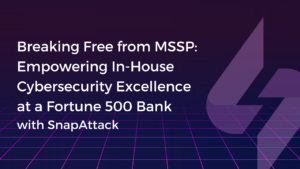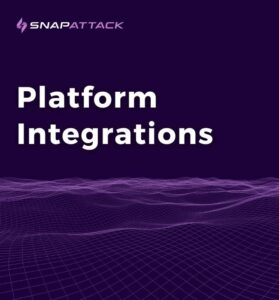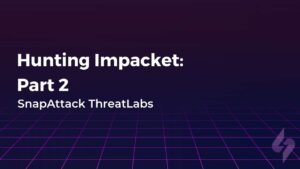What are Threat Profiles?
In a typical security operations center (SOC), the threat detection and response teams have one key objective: identify and stop the bad guys. To do so, they invest in the best tools, recruit the best team members, and work tirelessly to stay ahead of any potential security incidents that might be on the horizon.
Mediocre Threat intelligence platforms (TIPs) that focus exclusively on IOCs are a dime a dozen. While IOCs have their place in security, they aren’t helping teams generate strategic insights. Advanced TIPs that can describe who the threat actors are, what they want, how they operate, and provide more advanced indicators like TTPs, are less common, but come with an equally “advanced” price tag. Even more rare are solutions that make all of this information both actionable at a strategic level and accessible to organizations of all shapes, sizes, and maturity levels. As a result, only the largest and most well-funded organizations that are capable of building large and highly skilled threat intelligence teams that can take advantage of all of this information end up extracting the full value of these solutions and build effective Threat Profiles.
Threat Profiles can come in any number for formats, shapes, and sizes. Fundamentally, they are a description of all or most of the threats that have attacked or are most likely to attack your organization, based on motivations, regionality, technology, industry, etc. Organizations can use Threat Profiles to drive more strategic decisions across the security organization. Within Threat Detection specifically, Threat Hunters and Detection Engineers can leverage Threat Profiles to help them identify key focus areas for hunting exercises or detection development.
Attributes & Benefits of an Effective Threat Profile
Effective Threat Profiles Enable Dissemination → Information about threats, when not shared effectively with threat detection and response teams, is minimally valuable. Having all of the information about all possible threats at the fingertips of hunters, detection engineers, and incident responders is ultimately useless when teams don’t know which threats to drill deeper into. An effective threat profile simplifies and contextualizes threat intelligence and acts as a starting point for more strategic threat hunting, detection development, investigation, and response.
Effective Threat Profiles Are Dynamic → From one week to the next, or even one day to the next, the threat landscape can change and evolve in unpredictable ways. Without a highly skilled and dedicated team of Threat Intelligence Analysts, new threats and even old threats that are exhibiting new activity will fly under the radar. Effective threat profiles go beyond a static view and provide an updated and constant view into where organizations need to focus efforts without requiring expensive dedicated resources.
Effective Threat Profiles Are Actionable → Knowing what the threats are is nice, but being able to actually do something about those threats is what ultimately matters. Effective Threat profiles give teams the right information they need to pivot from threat to detection and hunt capability quickly and easily.
Challenges to Building an Effective Threat Profile
Too Much Data
Most security teams are overwhelmed by data that their tools aren’t designed to help them sift through. They might subscribe to IOC feeds and threat intelligence resources that bring them every piece of key adversarial information they’d ever need to know…but in this case, quantity certainly outweighs quality.
Not Enough Skill
Not Enough Collaboration
Most security teams operate less like a web and more like a group of silos. In a siloed structure, key teams like CTI, threat hunting, and detection engineering all work from disparate information, starting from scratch on each project, and aiming towards individual goals.
In reality, a well-oiled threat detection and response should be follow a unified security strategy, aiming for the same overarching objectives with each team playing a key role. These teams need collaborative, communicative workflows with distinct handoffs of responsibility.
Not Enough Money
Not Enough Time
How to Build & Utilize A Threat Profile
Step 1: Prioritize Threats
- Industry – “Which threat actors are targeting other organizations in our industry? How have they done it?”
- Region – “Which threat actors have targeted organizations in our region?”
- Technology – “Are there certain technologies used by our organization that make us more of a target for certain threats?”
- Motivations – “Is the actor financially motivated and looking to deploy ransomware? Or are we worried about a targeted attack, theft of IP, etc.?”
- Recency – “Is this threat new and actively used? When was it last observed?”
- Relevance – “How likely is this to impact our organization?”
- Prevalence – “How commonly are those tactics used?”
- Impact – “If it were to impact us, how bad would the damage be?”
Step 2: Map Prioritized Threats to Techniques
However, with over 200 Techniques and 500 Sub-Techniques, manually prioritizing which Techniques and Sub-Techniques are most relevant to all of the Threat Actors, Malware, and Tools that are part of the Threat Profile is simply untenable at scale. This process can be achieved easily with a handful of Threats, but becomes much harder with a truly comprehensive threat profile.
SnapAttack simplifies this process by automatically pivoting from your organization’s prioritized Threat Actors, Malware, and Tools into a single list of prioritized MITRE ATT&CK Techniques and Sub-Techniques.
Step 3: Identify Detection Gaps
Step 4: Fill Detection Gaps
Automate Your Threat Profile with SnapAttack
SnapAttack significantly enhances the efficiency and effectiveness of building and utilizing a threat profile for any organization.
By leveraging best-in-breed threat intelligence, SnapAttack autonomously generates and updates a comprehensive Threat Profile tailored to an organization’s unique attributes. This automated system translates the profile into prioritized MITRE ATT&CK Techniques and Sub-Techniques, thereby streamlining the identification and mitigation of detection gaps.
Moreover, SnapAttack centralizes ATT&CK Technique detection coverage, enabling teams to quickly identify and focus on high-priority techniques with low coverage. By offering pre-written, high-quality hunting queries and detection rules, SnapAttack enables Detection Engineers and Threat Hunters to bypass lengthy research and development processes. This results in more effective threat hunting and detection rule implementation across multiple platforms, ultimately fortifying an organization’s defense against evolving cyber threats.
Book a demo with SnapAttack to see how much time you could save on threat hunting and detection engineering.
About SnapAttack: SnapAttack is an innovator in proactive, threat-informed security solutions. The SnapAttack platform helps organizations answer their most pressing question: “Are we protected against the threats that matter?”
By rolling threat intelligence, adversary emulation, detection engineering, threat hunting, and purple teaming into a single, easy-to-use product with a no-code interface, SnapAttack enables companies to get more from their tools and more from their teams so they can finally stay ahead of the threat.



